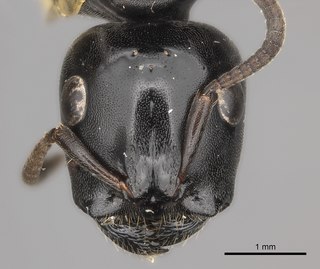
Bandipur National Park established in 1974 as a tiger reserve under Project Tiger, is a national park located in the Indian state of Karnataka, which is the state with the second highest tiger population in India. Along with adjacent Nagarhole National Park it is one of the premier Tiger Reserves in the country. It was once a private hunting reserve for the Maharaja of the Kingdom of Mysore but has now been upgraded to Bandipur Tiger Reserve. Bandipur is known for its wildlife and has many types of biomes, but dry deciduous forest is dominant.

Charles Thomas Bingham was an Irish military officer and entomologist.

Pseudomyrmecinae is a small subfamily of ants containing only three genera of slender, large-eyed arboreal ants, predominantly tropical or subtropical in distribution. In the course of adapting to arboreal conditions, the pseudomyrmecines diversified and came to occupy and retain a much wider geographic range.
Methanesulfonyl chloride (mesyl chloride) is an organosulfur compound with the formula CH3SO2Cl. Using the organic pseudoelement symbol Ms for the methanesulfonyl (or mesyl) group CH3SO2, it is frequently abbreviated MsCl in reaction schemes or equations. It is a colourless liquid that dissolves in polar organic solvents but is reactive toward water, alcohols, and many amines. The simplest organic sulfonyl chloride, it is used to make methanesulfonates and to generate the elusive molecule sulfene (methylenedioxosulfur(VI)).

Trophobiosis is a symbiotic association between organisms where food is obtained or provided. The provider of food in the association is referred to as a trophobiont. The name is derived from the Greek τροφή trophē, meaning "nourishment" and -βίωσις -biosis which is short for the English symbiosis.

Vachellia drepanolobium, commonly known as whistling thorn, is a swollen-thorn acacia native to East Africa. The whistling thorn grows up to 6 meters tall. It produces a pair of straight spines at each node, some of which have large bulbous bases. These swollen spines are naturally hollow and occupied by any one of several symbiotic ant species. The common name of the plant is derived from the observation that when wind blows over bulbous spines in which ants have made entry/exit holes, they create a whistling noise.

A domatium is a tiny chamber produced by plants that houses arthropods.

Tetraponera is a genus of ants in the subfamily Pseudomyrmecinae that are commonly known as slender ants and are characterized by their arboreal nature and slender bodies. The 86 described species of Tetraponera all live in hollow structures of plants and trees, such as thorns or branches; these hosts are known as myrmecophytes. Tetraponera species are closely related to the New World genus of ants Pseudomyrmex, but differ in their relationships with host plants.

Tetraponera rufonigra, is a species of ant belonging to the subfamily Pseudomyrmecinae. It is distributed across Asia, and Africa. Commonly called the Bi-coloured Arboreal ant, they are arboreal and build small nests which are excavated holes usually in dried parts of trees. They are active hunters and hunt small insects. They have a well developed sting and when stung can cause allergic reactions in human beings.

Tetraponera nigra, is a species of ant of the subfamily Myrmicinae, which can be found in Borneo, Philippines, Bangladesh, India, Sri Lanka, Thailand, China.

Electromyrmex is an extinct genus of ants in the formicid subfamily Dolichoderinae. The genus contains a single described species, Electromyrmex klebsi and is known from a group of Middle Eocene fossils which were found in Europe.
Tetraponera penzigi, is a species of ant of the subfamily Pseudomyrmecinae, which can be found in East Africa. It forms an obligate symbiosis with the whistling thorn, a dominant tree in some upland areas of East Africa.
Barteria fistulosa is a species of tree in the family Passifloraceae, native to tropical Central Africa. The tree has an association with an aggressive species of ant with a very painful sting, which lives in its hollow branches and twigs, and gives rise to its common name of "ant tree".
Tetraponera tessmanni is a species of ant in the subfamily Pseudomyrmecinae, which is native to tropical Central Africa, where it inhabits the hollow stems of the liana Vitex thyrsiflora.
Vitex thyrsiflora is a species of woody vine in the family Lamiaceae. It is native to tropical West and Central Africa. Its hollow stem is used as a home by an aggressive species of ant.

Tetraponera aethiops is a species of ant in the subfamily Pseudomyrmecinae, which is native to tropical Africa. It is found living in the forest in association with Barteria fistulosa, a small tree.
This page is based on this
Wikipedia article Text is available under the
CC BY-SA 4.0 license; additional terms may apply.
Images, videos and audio are available under their respective licenses.











